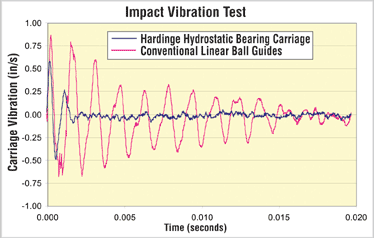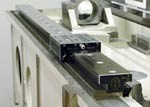New 'Ways' For Hard Turning
This company went to work to improve the surface finish and tool life in hard turning applications.
Share



The way system on machine tools is designed to perform two basic functions. Its first role is to provide an accurate track for the moving components to travel on. The second is to act as a channel to direct the dynamic forces generated in cutting away from the cutting zone.
This second task is critical for hard turning because the ability of the machine tool to damp or channel the cutting forces has a direct impact on the surface finish and tool life of an application. Hardinge, Inc. has developed a new hydrostatic way system ideal for hard turning applications.
At IMTS 2000, Hardinge demonstrated hard turning on its Quest turning center with conventional ways installed. The demo part was hardened to 64 Rc with interrupted cuts. The machine produced a surface finish of 15 Ra with tool life of three parts per insert.
Using that performance as a benchmark, the company went to work to improve the surface finish and tool life in hard turning applications. Fast forward to IMTS 2002. The show part was the same as 2000, and cutting conditions were identical, but the surface finish coming off the Quest 8/51 was measured at 7 Ra, and the tool life was 11 parts per insert. The difference between the two demos was a new hydrostatic way system applied to the IMTS 2002 machine.
The new hydrostatic system uses a closed loop, pressurized, oil delivery system (1,000 psi) to maintain the gap between the stationary rail and the moving truck. The truck moves across the guideway on a cushion of oil with no metal-to-metal contact.
Because it is hydrostatic, with no metal-to-metal contact, this new way system allows faster traverse rates. The new machine equipped with the hydrostatic system is capable of 2,360 ipm in the Z axis compared with 1,500 ipm in the IMTS 2000 machine. Pockets milled into the truck regulate the fluid pressure in response to a changing fluid gap. When a load is applied to the truck, the oil pressure in the pocket increases, creating a restoring force that prevents the fluid gap from closing. It’s the fluid gap and the surface area of the truck that combine to provide the hard turning damping performance on this way system.
To graphically see how this compares with conventional linear guideway systems, two tests were performed. The first (Figure 1) measured the ability of the way system to settle after an impact. This test represents the kind of vibration induced by an interrupted cut. A second test (Figure 2) compares the dynamic stiffness of the two way systems in continuous cutting. This test simulates chatter resistance.
The amount of vibration within the cutting zone is a measure of the overall damping efficiency of the way system. Hard turning operations exacerbate even small amounts of vibration because the workpiece surface finish requirement is similar to grinding.
Vibration also has a direct impact on cutting tool life, especially in hard turning applications. The inserts used in hard turning are generally much harder and therefore more brittle than conventional turning. Micro cracks induced by vibration can lead to premature failure of the tool.





















.png;maxWidth=300;quality=90)








